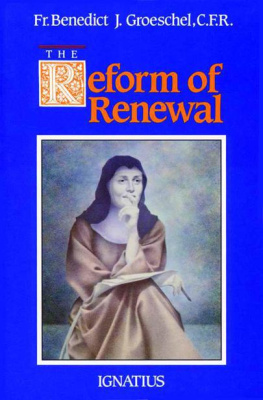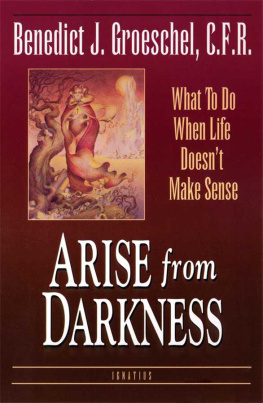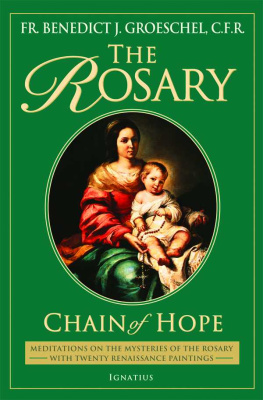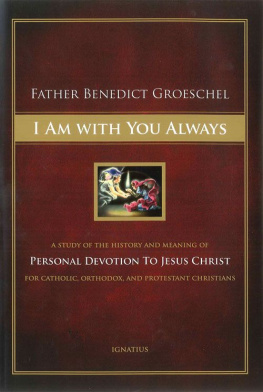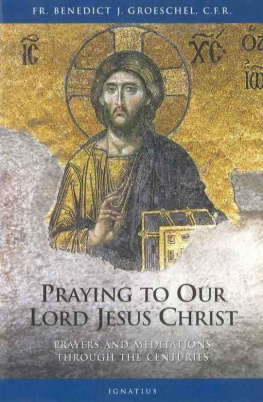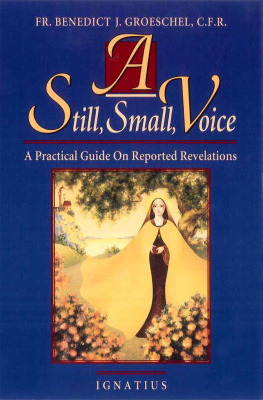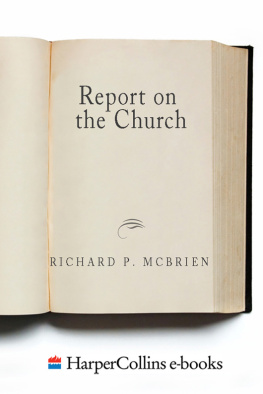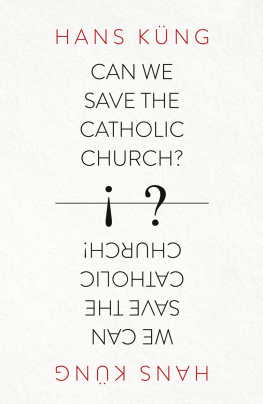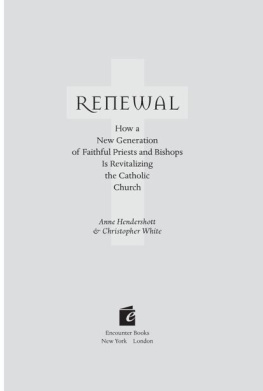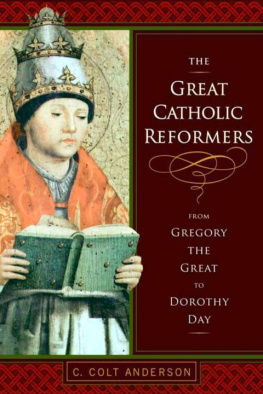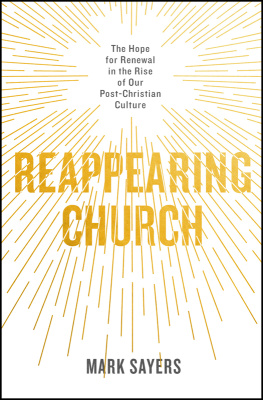THE REFORM OF RENEWAL
FR. BENEDICT J. GROESCHEL, C.F.R.
THE REFORM OF RENEWAL
IGNATIUS PRESS SAN FRANCISCO
Cover art: St. Clare of Assisi by John Lynch
Cover design by Riz Boncan Marsella
1990 Ignatius Press, San Francisco
All rights reserved
ISBN 0-89870-286-0
Library of Congress catalogue number 90-81769
Printed in the United States of America
To Some Great Women of Reform from the Past:
CLARE OF ASSISI
CATHERINE OF SIENA
CATHERINE OF GENOA
and of the present:
MOTHER TERESA
MOTHER PAULA
MOTHER ANGELICA
CATHERINE DOHERTY
DORTHY DAY
CONTENTS
FOREWORD
Religious sociologists today speak of the new voluntarism as one of the most significant religious changes in American churches. Today we are confronted with a radically individualistic religiosity. Choice means more than simply selecting which church one will belong to; choice involves religion itself as an option as well as the opportunity to draw selectively from a variety of traditions in pursuit of the self. Questions of authority, discipline, religious practice and common life often seem foreign, or at least unimportant.
Robert Bellow, in one of his books, characterizes the modern American religious experience in the person of Sheila Larson who says: I believe in God. Im not a religious fanatic. I cant remember the last time I went to church. My faith has carried me a long way. Its Sheilaism. Just my own little voice.
Father Benedicts sound Catholic ecclesiology offers an antidote to the rampant individualism that has invaded American religiosity and that is so foreign to the communal aspect of Catholicism which includes our communion with our ancestors in the faith, the host of witnesses stretching back to the apostles and martyrs. The mystery of the Church, the guiding presence of the Spirit in the Magisterium, the legacy of holiness in our saints and heroes are all part of the backdrop for personal conversion and community change that mean reform.
As Pope John Paul II points out in Christifideles Laici , our Catholic people are commissioned by their baptism and confirmation to transform society. Father Benedict echoes this challenge in the opening chapters. The relative prosperity of the last twenty-five years has induced a flabby, comfortable religion that fails to face the conflict between time and eternity. The mediocrity of these times cries out for reform. Our author explores various areas of Christian living which apply to all believers, lay and religious, and which are key aspects of an authentic renewal, such as faith, emotions, sexuality. Father Benedict brings the reader a modern psychological approach tempered by common sense and personal experience.
In the later chapters of the book, Father Benedict looks at the clergy and religious life. His clinical assessment of religious life may at times sound harsh, but at the same time he is hopeful that religious life can experience a rebirth. It is clear from Church history that Francis, with his reform of religious life, or Teresa of Avila and John of the Cross with their reform of the Carmelite family, had a great impact on the Church at large. Mother Teresa once stated that the renewal of the Church depends on the renewal of priests; however, we might add that the renewal of religious life will help greatly the renewal of the Church. This renewal begins with personal conversion, but it does not end there. The asceticism and authority structure of religious life must be rescued from modern tendencies toward individualism and relativism. Society needs to find the careful balance between personal freedom and responsibility to the common good.
American culture exalts individual freedom over most other values. Truth, even life itself, are jeopardized by this cultural bias that is so pervasive in our country. Reform will require a common vision and commitment strong enough to break through the patterns of secular society which are so ingrained in the American mind. Father Benedict faces these issues in his reflections on religious life in the United States,
Father Benedict is not the subtle doctor. He is like John Hancock who wrote big so that King George would be able to see his signature without using his eyeglasses. For so long, people have denied the proportions of the crisis in religious life and the Church. Father Benedict looks for an explanation of the collapse of so many religious communities. Not everyone will agree with his conclusions, but I believe that his book will challenge all of us to confront the present realities and commit ourselves to work for a new flourishing of religious life and practice in the Church.
For the author, the topic of reform is not an academic one but rather part of a personal passion and spiritual odyssey which has led him to participate in the founding of a new community of Franciscans in the Capuchin tradition. The new family of friars will undoubtedly seem like a testing ground for many of Father Benedicts convictions. As we wait to see the results of this experiment, we ponder the eloquent cry for reform whose echo grows louder and louder.
+ Most Reverend Sean OMalley, O.F.M., Cap.
Bishop of the Virgin Islands
ACKNOWLEDGMENTS
I am deeply grateful to the great reformers of the Church who inspired this attempt to confront our times with this perennial message of the Gospel. I wish to thank Mother Claudia, I.H.M., for the title of this book and Fr. Joseph Fessio S.J. of Ignatius Press for his constant encouragement.
Preparing the manuscript would have been impossible without the very professional help of Charles Prendergast and Claudia McDonnell. I am grateful to Elaine Barone and Catherine Murphy, who type so very many things for meand to John Lynch for the third magnificent cover he has provided for my books.
I am grateful, also, to my confrere and friend Most Rev. Sean OMalley, O.F.M., Cap., Bishop of St. Thomas in the Virgin Islands for the Foreword, and to Richard Roach, S.J. of Marquette University for many suggestions.
Finally, I am grateful to the earnest young reformers of the Community of Franciscan Friars of the Renewal and the Community of Franciscan Sisters of the Renewal for the inspiration they have given me to hope that reform is possible in our time.
Fr. Benedict Joseph Groeschel, C.F.R.
Easter, 1990
Chapter One
REFORM: A HUMAN NECESSITY
Reform: A New Face
Religion is dying or dead. This is the verdict passed by many in the Western industrialized nations, especially in northern Europe, where active participation in the churches is less than 10 percent. In the progressive countries of Scandinavia active participation is reduced to about 1 or 2 percent of the population. There are signs that this fatal illness is spreading to southern Europe, the United States and Canada, where active participation in Church life has dropped at least 50 percent since 1959. Many of the large mainstream denominations count their losses in hundreds of thousands. The Catholic Church tends to retain people in membership long after any real participation has ceased, but it is safe to say that Mass attendance by Catholics has dropped at least 50 percent in the past thirty years. Religious communities and diocesan clergy continue to attract fewer and fewer members.
Is there a way out? This book proposes that the only effective way back to life is through the essential step described in the Gospel and indicated by all religions of the world. This reform focuses on individual spiritual development and thorough, ongoing personal reform, which then give rise to communal and societal reform.
An Unlikely Model
For most people the word reform conjures up a grim and unappealing specter. It wears an inky black cape of sorrow and has an angry face and an inhumane spirit. To dispel this image I have dedicated this book to one of the great reformers of Church history, Saint Clare of Assisi (1194-1253). Her bright, smiling, youthful spirit is captured by the painting on the cover of this book.
Next page
